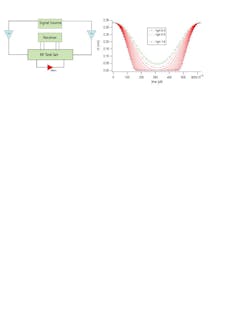For telecommunications applications, Doherty power-amplifier (PA) configurations can offer excellent power efficiency while accommodating the high peak-to-average-power ratios (PAPRs) of the latest modulation schemes. Load-pull techniques are highly valuable in optimizing and tuning these PA configurations to better performance. In an application note from Mesuro, “Application of the Mesuro Active Load-Pull System in Doherty Power Amplifier Design and Optimization,” the authors disclose techniques for defining Doherty PA performance and enhancing PA designs.
The note describes how a Doherty amplifier acts like an active load-pull system between two amplifiers, connected to each other by the impedance transformer. The impedance at the output of each device varies as a function of the envelope magnitude. This factor requires certain output dynamics to be de-embedded to capture the internal behavior of a Doherty PA and optimize the bias voltages. To generate measurement data with a reference at the current generator plane, the resulting currents and voltages are combined with the synthesis of the input drive, output load impedance, and bias conditions.
For the bias conditions, each device needs to be estimated with direct-current (DC) measurements and steadily refined using the RF waveforms in isolation. Load-pull aids in deciding the optimum impedance. The main amplifier is initially tested and refined. The bias and load-pull waveforms from these earlier tests are used to aid in refining the auxiliary, or peaking, amplifier’s behavior. It should be noted that reliability is an issue with the auxiliary amplifier. The note cautions engineers to keep the generated voltages below the breakdown threshold of the auxiliary amplifier while operating in the high-impedance state.
After the devices are effectively biased and their performance is analyzed in isolation, a matching network between the devices can be designed. During this process, the note explains how tradeoffs must be made. Here, iterative testing will provide the best insight into the realistic performance of the manufactured design. This analysis process can be used with immature device processes to help gain in-depth understanding of process limitations, and even aid in illuminating possible redesign approaches for enhanced functionality.
Mesuro Ltd., Pencoed Technology Park, Pencoed, UK CF35 5HZ
About the Author
Jean-Jacques DeLisle
Jean-Jacques graduated from the Rochester Institute of Technology, where he completed his Master of Science in Electrical Engineering. In his studies, Jean-Jacques focused on Control Systems Design, Mixed-Signal IC Design, and RF Design. His research focus was in smart-sensor platform design for RF connector applications for the telecommunications industry. During his research, Jean-Jacques developed a passion for the field of RF/microwaves and expanded his knowledge by doing R&D for the telecommunications industry.

